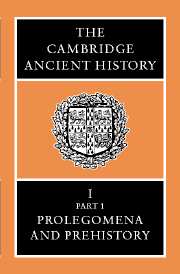Book contents
- Frontmatter
- Contents
- List of Maps
- List of Tables
- List of Text-figures
- Preface
- Chapter I The Geological Ages
- Chapter II Physical Conditions in Eastern Europe, Western Asia and Egypt Before the Period of Agricultural and Urban Settlement
- Chapter III Primitive Man in Egypt, Western Asia and Europe in Palaeolithic Times
- Chapter IV The Evidence of Language
- Chapter V The Earliest Populations of Man in Europe, Western Asia and Northern Africa
- Chapter VI Chronology
- Chapter VII (a) The Earliest Settlements in Western Asia from the Ninth to the End of the Fifth Millennium B.C.
- Chapter VII (b) Anatolia Before 4000 B.C.
- Chapter VIII The Development of Cities From Al-‘Ubaid to the End of Uruk 5
- Chapter IX (a) Predynastic Egypt
- Chapter IX (b) Palestine During the Neolithic and Chalcolithic Periods
- Chapter IX (c) Cyprus in the Neolithic and Chalcolithic Periods
- Chapter X The Stone Age in the Aegean
- Bibliographies
- Index to Maps
- General Index
- Maps
Chapter VII (b) - Anatolia Before 4000 B.C.
Published online by Cambridge University Press: 28 March 2008
- Frontmatter
- Contents
- List of Maps
- List of Tables
- List of Text-figures
- Preface
- Chapter I The Geological Ages
- Chapter II Physical Conditions in Eastern Europe, Western Asia and Egypt Before the Period of Agricultural and Urban Settlement
- Chapter III Primitive Man in Egypt, Western Asia and Europe in Palaeolithic Times
- Chapter IV The Evidence of Language
- Chapter V The Earliest Populations of Man in Europe, Western Asia and Northern Africa
- Chapter VI Chronology
- Chapter VII (a) The Earliest Settlements in Western Asia from the Ninth to the End of the Fifth Millennium B.C.
- Chapter VII (b) Anatolia Before 4000 B.C.
- Chapter VIII The Development of Cities From Al-‘Ubaid to the End of Uruk 5
- Chapter IX (a) Predynastic Egypt
- Chapter IX (b) Palestine During the Neolithic and Chalcolithic Periods
- Chapter IX (c) Cyprus in the Neolithic and Chalcolithic Periods
- Chapter X The Stone Age in the Aegean
- Bibliographies
- Index to Maps
- General Index
- Maps
Summary
XI. GEOGRAPHICAL INTRODUCTION
The term Anatolia is used throughout this division to describe Turkey in Asia, including Cilicia, but excluding the regions east of the Amanus and south of the eastern Taurus, the cultures of which are evidently more related to those of Syria and northern Mesopotamia. This crescent of mountains stretching without a break from the Mediterranean to the western borders of Persia neatly defines the southern edge of Anatolia, even though it never presented an impassable barrier. It often formed a cultural frontier, and there was sufficient traffic through the passes to make it act as a political frontier as well. Cilicia, or rather the plain of Cilicia, is often singled out as a more or less independent unit on account of a similar geographical position south of the Taurus, but recent research shows conclusively that, although it maintained contacts with both the Anatolian plateau and north Syria, it should both archaeologically and philologically be considered a part of Anatolia.
To understand the development of Anatolian cultures and civilization, a geographical knowledge of the country is a prerequisite. Three main factors must be emphasized: its size, its mountainous character, and its forests. Superimposed on a map of Europe Anatolia extends from Calais to the Russian frontier, from Denmark to Rome or from Amsterdam to Gibraltar. Anatolia is a highland country, most of it over 2000 ft. high and gradually rising to an altitude of 5000–6000 ft. in the east. Prehistoric Anatolia was mostly covered in forest and woodland and a great part of it still is so. Many of the now semi-arid and barren regions with a steppe climate are the result of man-made changes, overgrazing and deforestation, perhaps accelerated by a steady rise in winter temperatures since late Roman times.
Completely enclosed by two parallel ranges of rugged mountains, the Taurus and the Pontic chains, all natural communications run from east to west. Both chains present precipitous cliffs along much of their course, and coastal plains are therefore few and far between, and of limited extent, with the single exception of the Cilician plain. Prehistoric occupation is found on the north coast only in the Samsun area and along the Rion valley in Colchis, where rivers running down from the high plateau have carved natural routes. Along the Mediterranean one finds the same situation.
- Type
- Chapter
- Information
- The Cambridge Ancient History , pp. 304 - 326Publisher: Cambridge University PressPrint publication year: 1970



